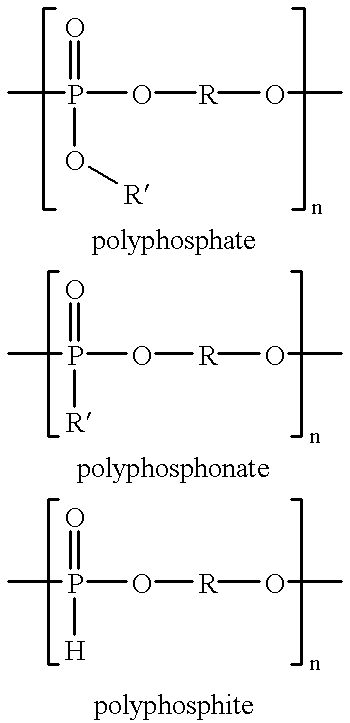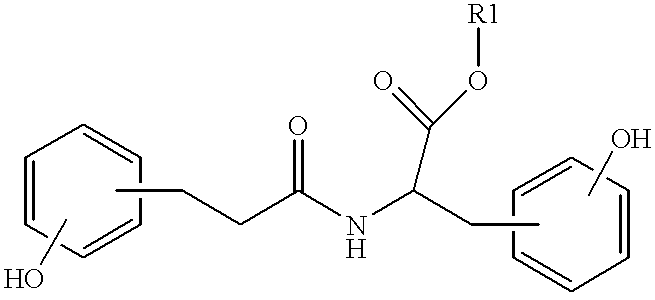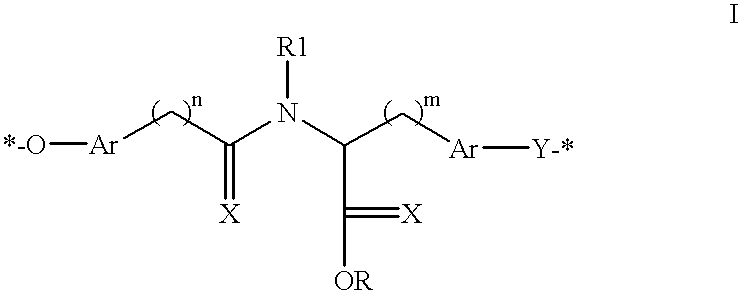Biodegradable polymers, compositions, articles and methods for making and using the same
a biodegradable polymer and composition technology, applied in the field of biodegradable polymers, compositions, articles and methods for making and using the same, can solve the problems of unsatisfactory conventional drug delivery methods, and high initial drug level,
- Summary
- Abstract
- Description
- Claims
- Application Information
AI Technical Summary
Problems solved by technology
Method used
Image
Examples
example 2
Synthesis of the Corresponding PCH(phosphoester-co-amide) P(DTTH-EOP) ##STR30##
Under an argon stream, 7.8 g of desaminotyrosyl tyrosine hexyl ester (DTTH), 5.07 g of 4-dimethylaminopyridine (DMAP), and 50 ml of methylene chloride were transferred to a 250 ml flask equipped with a funnel. A solution of 3.07 g of ethyl phosphodichloridate (EOP) in 30 ml of methylene chloride was added to the funnel. The solution in the flask was cooled down to -40.degree. C. with stirring, and the EOP solution was added dropwise through the funnel. When the addition was complete, the mixture was gradually brought up to a temperature of 45.degree. C. and was maintained at reflux temperature overnight.
The solvent was then evaporated, and a vacuum (0-1 mm Hg) was applied for one hour while the temperature of the residue was maintained at 120.degree. C. The residue was redissolved in 100 ml of chloroform, washed with a 0.1 M solution of HCl in distilled water, dried over anhydrous Na.sub.2 SO.sub.4, and q...
example 3
Properties of P(DTTH-EOP)
A P(DTTH-EOP) polymer was prepared as described above in Example 2. The resulting poly(phosphoester-co-amide) polymer was analyzed by GPC using polystyrene as a standard, and the resulting graph established an Mw of 5,450 and an Mn of 1,670. The polydispersity (Mw / Mn) was determined to be 3.27.
The polymer was very soluble in chloroform, dichloromethane, dimethylformamide, and dimethyl sulfoxide; soluble in N-methylpyrrolidone; and swelled in ethanol, methanol, acetone, acetonitrile and tetrahydrofuran. The intrinsic viscosity was measured in chloroform (CH.sub.3 Cl) at 40.degree. C. and determined to be 0.055 dL / g.
The Tg of the polymer was determined by differential scanning calorimetry ("DSC") to be 55.6.degree. C., as shown in FIG. 1. No melting peak was observed in the DSC curve.
PUM
| Property | Measurement | Unit |
|---|---|---|
| Fraction | aaaaa | aaaaa |
| Fraction | aaaaa | aaaaa |
| Fraction | aaaaa | aaaaa |
Abstract
Description
Claims
Application Information
 Login to View More
Login to View More - R&D
- Intellectual Property
- Life Sciences
- Materials
- Tech Scout
- Unparalleled Data Quality
- Higher Quality Content
- 60% Fewer Hallucinations
Browse by: Latest US Patents, China's latest patents, Technical Efficacy Thesaurus, Application Domain, Technology Topic, Popular Technical Reports.
© 2025 PatSnap. All rights reserved.Legal|Privacy policy|Modern Slavery Act Transparency Statement|Sitemap|About US| Contact US: help@patsnap.com



